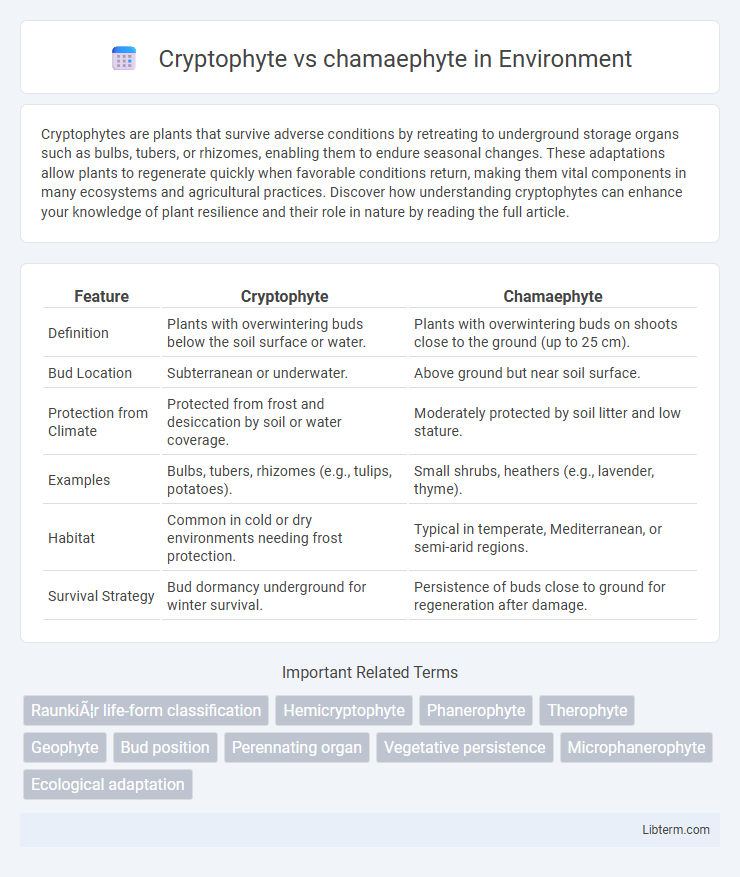Cryptophytes are plants that survive adverse conditions by retreating to underground storage organs such as bulbs, tubers, or rhizomes, enabling them to endure seasonal changes. These adaptations allow plants to regenerate quickly when favorable conditions return, making them vital components in many ecosystems and agricultural practices. Discover how understanding cryptophytes can enhance your knowledge of plant resilience and their role in nature by reading the full article.
Table of Comparison
| Feature | Cryptophyte | Chamaephyte |
|---|---|---|
| Definition | Plants with overwintering buds below the soil surface or water. | Plants with overwintering buds on shoots close to the ground (up to 25 cm). |
| Bud Location | Subterranean or underwater. | Above ground but near soil surface. |
| Protection from Climate | Protected from frost and desiccation by soil or water coverage. | Moderately protected by soil litter and low stature. |
| Examples | Bulbs, tubers, rhizomes (e.g., tulips, potatoes). | Small shrubs, heathers (e.g., lavender, thyme). |
| Habitat | Common in cold or dry environments needing frost protection. | Typical in temperate, Mediterranean, or semi-arid regions. |
| Survival Strategy | Bud dormancy underground for winter survival. | Persistence of buds close to ground for regeneration after damage. |
Introduction to Cryptophytes and Chamaephytes
Cryptophytes are perennial plants that survive unfavorable seasons through underground storage organs such as bulbs, tubers, or rhizomes, enabling rapid regrowth when conditions improve. Chamaephytes, on the other hand, are small shrubs or woody perennials with buds located close to the ground, typically less than 25 cm above the soil surface, which protects them from environmental stress. Both life forms represent adaptive strategies in plant ecology, allowing survival in challenging climates by protecting vital tissues during adverse periods.
Defining Cryptophytes: Key Characteristics
Cryptophytes are perennial plants characterized by their subterranean storage organs such as bulbs, tubers, or rhizomes that enable survival during unfavorable seasons. These adaptive structures protect meristems underground, allowing cryptophytes to regenerate foliage and flowers after periods of dormancy. In contrast to chamaephytes, which keep their buds close to the soil surface, cryptophytes rely on hidden, below-ground organs as a key survival strategy in harsh environmental conditions.
Understanding Chamaephytes: Main Features
Chamaephytes are perennial plants characterized by their buds located close to the ground, typically within 25 cm above the soil surface, which offers protection against harsh environmental conditions. These plants possess woody stems that remain year-round, allowing them to survive in cold or dry climates by minimizing exposure to extreme weather. Understanding the structural adaptations of chamaephytes highlights their ecological strategy for resilience, contrasting with cryptophytes, which protect their regenerative buds below the soil surface.
Habitat and Ecological Roles
Cryptophytes, adapted to environments with seasonal extremes, survive unfavorable conditions through underground storage organs such as bulbs or tubers, typically thriving in temperate to cold habitats. Chamaephytes persist in harsh, often arid or alpine environments, with their perennating buds positioned close to the ground to avoid damage from wind and frost. Ecologically, cryptophytes contribute to soil stabilization and nutrient cycling during their dormant phases, while chamaephytes play a crucial role in preventing erosion and providing shelter in exposed habitats.
Morphological Differences
Cryptophytes possess buds located below the soil surface, often as bulbs, tubers, or rhizomes, enabling survival through adverse conditions, whereas chamaephytes bear persistent buds close to the ground, typically within 25 centimeters above soil level, facilitating protection from environmental stress. Morphologically, cryptophytes exhibit underground storage organs that support regrowth, while chamaephytes have woody, low-growing stems that remain exposed but guarded by insulating structures like dense hairs or scales. These distinctions in bud positioning and stem structure directly influence their adaptive strategies in varying climates and ecosystems.
Adaptations to Environmental Stress
Cryptophytes survive environmental stress by storing their buds underground or underwater, protecting them from frost, drought, and fire, which allows rapid regeneration during favorable conditions. Chamaephytes, with their buds close to the ground, benefit from insulation by soil or snow, reducing damage from cold and wind exposure. Both strategies enhance survival in harsh climates by safeguarding growth points against temperature extremes and desiccation.
Seasonal Growth and Dormancy
Cryptophytes survive unfavorable seasons by retreating to underground storage organs like bulbs, corms, or tubers, enabling regrowth when conditions improve. Chamaephytes maintain above-ground perennial buds close to the soil surface, allowing them to endure seasonal stresses such as frost or drought. This strategic positioning of buds in chamaephytes supports immediate growth after dormancy, while cryptophytes rely on underground structures to initiate seasonal regeneration.
Ecological Significance and Biodiversity
Cryptophytes, which survive adverse seasons through underground storage organs, enhance ecosystem resilience by maintaining plant diversity and supporting soil stability. Chamaephytes, with their above-ground perennial buds, contribute to biodiversity by providing continuous habitat and food sources for various fauna, especially in harsh environments. Both life forms play crucial roles in ecological succession and habitat complexity, promoting overall ecosystem health and species richness.
Examples of Cryptophytes and Chamaephytes
Cryptophytes include plants like tulips (Tulipa spp.) and potatoes (Solanum tuberosum) that survive adverse seasons through underground storage organs such as bulbs, corms, or tubers. Chamaephytes, exemplified by heather (Calluna vulgaris) and common boxwood (Buxus sempervirens), maintain their perennating buds close to the ground, typically within 25 cm above soil, enabling survival in harsh climates. These distinct adaptations in cryptophytes and chamaephytes reflect their ecological strategies for enduring unfavorable environmental conditions.
Conclusion: Comparing Plant Life Strategies
Cryptophytes survive unfavorable seasons through underground storage organs, enabling rapid regeneration when conditions improve, while chamaephytes maintain perennial buds close to the ground to withstand climatic stress. This fundamental difference highlights cryptophytes' adaptive strategy for dormancy and resource storage versus chamaephytes' emphasis on structural resilience and protection. Understanding these contrasting life strategies provides critical insights into plant ecological distribution and habitat specialization.
Cryptophyte Infographic

 libterm.com
libterm.com